Tom Parkinson's monthly column, introducing the diverse range of flora and fauna on show at Sanctuary Lakes.
Sanctuary Lakes Resort was developed on the eastern extremities of one of the world's largest lava plains, the Western Plain which stretches from Melbourne to Mount Gambier in South Australia. Our location beside Port Phillip Bay allowed the lava flows to form a network of salt water wetlands. This weathered the lava basalt and released minerals in turn enriched the soil. Added to which, Sanctuary Lakes developers brought in the Burnley Tunnel's clay soils to build the golf course and assist in establishing the landscaping for the houses and streets. In order to enhance the initial vision of a links golf course and integrate the housing into the original lava basalt and wetland plain, it was decided to plant some of the original endemic Australian tussock grasses in key positions around the estate. To make viewing of these grasses and tussocks easier, I am just going to take just five samples that can been seen from the public laneway between the 1st and 10th tee and roadside near the starters hut and putting green. As always once you recognise the plants, it becomes extremely simple to see them flourishing in other areas of the resort.
The five are: The tussock grass Poa Libillardieri, Morrisii and Clelandi, the Salt Couch Sorobolus Virginicus and the wetland succulent the Beaded Glasswort. Unfortunately my powers of description fail when describing some of the subtle differences between tussock grasses so I am letting the photographs tell some of the story.
First we will look at the three Poa Tussock grass. Poa is the genus for 500 species of grass, 15 of which are endemic to Australia. The word Poa is Greek for Fodder. All our Poa grass flower in late spring and early summer. All are fodder grass therefore require a bi-annual haircut or burn.
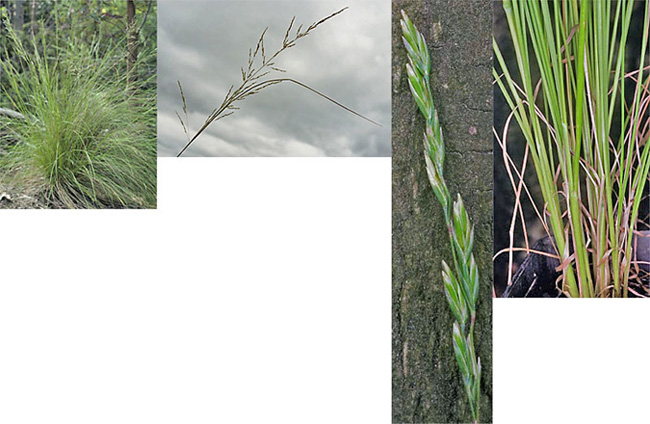
Poa labillardieri - Common name Tussock Grass and also the most common tussock grass around the golf course. It is the largest tussock on the Resort, growing to 1m high and wide. Colour varies to the time of the year. Most forms have attractive elegant Blue-green leaves. Flower stems are fine open panicles and may be erect or weeping.
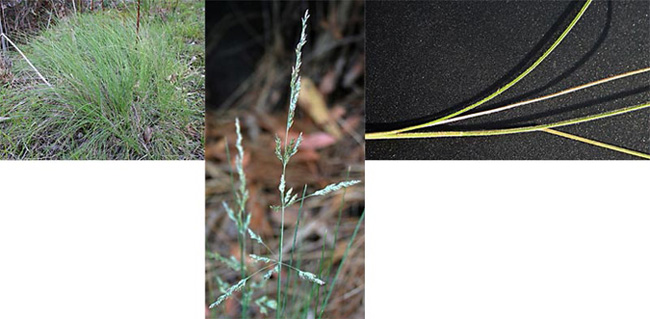
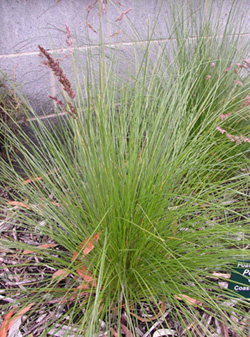 Poa clelandii Poa morrisii - Common name Velvet Tussock Grass. Medium, erect tussock, with hairy stems giving a soft greyish appearance grows to about half a metre, but the Flower stems will grow to 1 m high and change from a distinct bleu/green to an ochre similar to rye grass. Clumps increase slowly in width and can become very tangled and flattened if not regularly cut back.
Poa clelandii Poa morrisii - Common name Velvet Tussock Grass. Medium, erect tussock, with hairy stems giving a soft greyish appearance grows to about half a metre, but the Flower stems will grow to 1 m high and change from a distinct bleu/green to an ochre similar to rye grass. Clumps increase slowly in width and can become very tangled and flattened if not regularly cut back.
Poa clelandii - Common name Matted Tussock Grass. Medium, erect tussock with very fine, bright green leaves and flower stems to 50cm high. Flowers move from ochre to purple upon maturity.
Sporobolus virginicus - common name is Salt Couch – is a creeping rhizomatous perennial growing to 50 cm tall, with lanceolate, spine-tipped leaf-blades characterised by two rows of sharp stiff leaves on opposite sides of the same flat plane. Flowers mostly early summer through to autumn but does not always set viable seed. A robust network root system, tolerant to clay, sand and salinity, giving it, the often used ability to stabilize sloping and eroding soil patches.
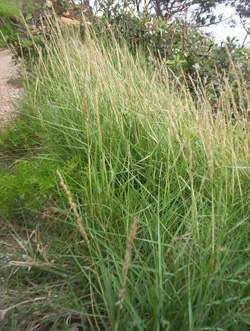 Sporobolus virginicus Sarcocornia quinqueflora - Common name Beaded Glasswort. A succulent that can be seen around the putting green and first Tee and also in large quantities along the wet land of the 16th fairway. Beaded Glasswort is a salt pan soil plant and would have grown in plentiful numbers on the local wetlands prior to Sanctuary Lakes Resort development.
Sporobolus virginicus Sarcocornia quinqueflora - Common name Beaded Glasswort. A succulent that can be seen around the putting green and first Tee and also in large quantities along the wet land of the 16th fairway. Beaded Glasswort is a salt pan soil plant and would have grown in plentiful numbers on the local wetlands prior to Sanctuary Lakes Resort development.
Glasswort is an English word which came into use with the 16th century resurgence in English glassmaking that had suffered a long decline since Roman times. This resurgence was led by glassmakers who emigrated to England from Lorraine and Venice. The glassmakers brought with them the technology of cristallo, the immaculately clear glass that used soda ash made from burnt Sarcocornia as the flux. Hence the name Glasswort, with Wort being an old English name for a plant or herb.
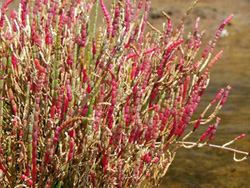 Sarcocornia quinqueflora The Australian native Beaded Glasswort is a fleshy perennial, with stems that initially spread horizontally then turn upwards, rooting at the nodes to 30 cm high. Flowers in spring with miniscule white dots and inconspicuous circular seeds. The fleshy stems change colour in mid-summer (now) from green to a rich purple.
Sarcocornia quinqueflora The Australian native Beaded Glasswort is a fleshy perennial, with stems that initially spread horizontally then turn upwards, rooting at the nodes to 30 cm high. Flowers in spring with miniscule white dots and inconspicuous circular seeds. The fleshy stems change colour in mid-summer (now) from green to a rich purple.
Glasswort's spring green stems are very edible and can be eaten raw or blanched like Asparagus. They taste great, like crunchy, salty beans. Rich in vitamins A, B + C and also folic acid. It has been traditionally used by the early European settlers to promote liver and kidney function.
These five endemic Australian plants are vigorously growing and relatively easily seen in the area of the first to tenth tee, along with the ubiquitous Lomandra Longiffolia or Spiky-headed Mat-rush, the large attractive grass that is established around the footpaths of Sanctuary Lake Resort's entrance. We discussed Spiky head in last year’s January Rubik. There is also a very interesting tree presently standing two metres tall between the first tee and the ninth green - a wild nectarine! See if you can spot it. Unfortunately the Bats get the fruit before they reach the tenderness for human consumption.
Greg Norman when he designed the course insisted the tussock grass Poa Hideaballus was planted along the fairways. Although many of my golfing partners insist its weed like presence constantly appears in the rough, I am unable as yet, to find its genus in the Botanical Lexicon.